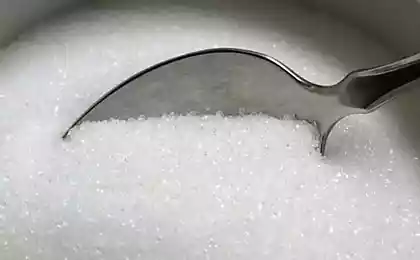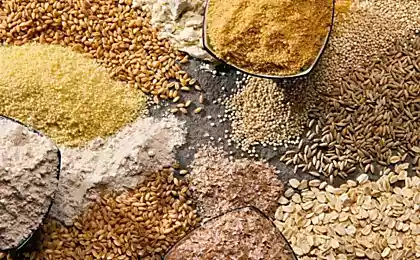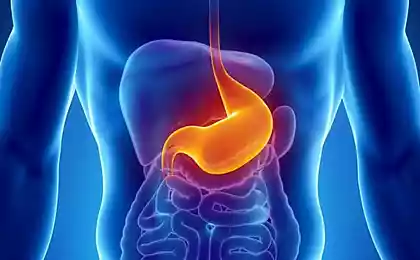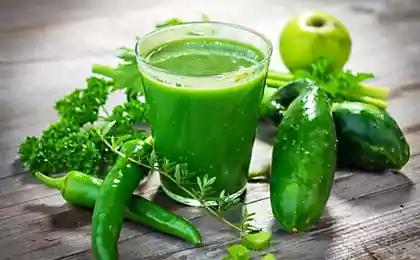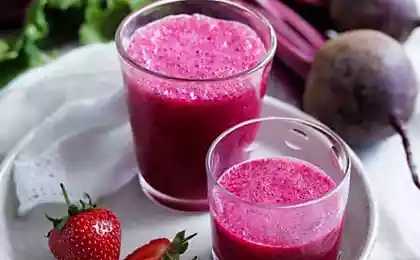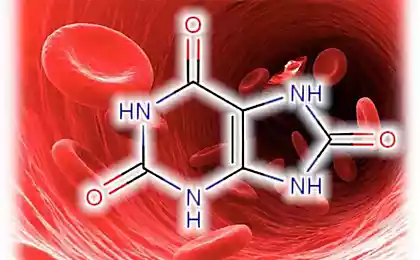551
The epidemic is freshly squeezed and packaged juices: 12 strokes to your health
But to date fruit juices cannot be considered a useful and necessary drink, especially for children. The active promotion of the use of fruit juices — no more than a marketing technique.
In America and then in Europe, the daily consumption of freshly squeezed juice has become a trend, a cult. In our environment the imposition of juice is also very aggressive. Spend juice detox, cure disease and even trying to live.
Below I will tell you why this is all wrong and why juice, even freshly squeezed, essentially sugar water. For example, 250 ml of Apple juice contain 110 kcal and 26 g of sugar and Coca-Cola in the same volume contains 105 kcal and 26.5 g of sugar. The difference is insignificant, and the action is the same.

Strike one: sugar. 1 Cup (200 ml) of any fruit juice WITHOUT SUGAR contains an average of 20-24 mg of sugars, which for 30 minutes will increase blood glucose by 3-4 mmol\L. On the content of sugars (free, they are also extracellular, added, rastvornye) as packaged nectars and fresh-squeezed juices comparable to sweet drinks. And this sugar, liquid calories, acts on the body just like a Cola or sprite. This is due to the fact that many juices, including baby food, contain at least six teaspoons of sugar (200 ml) – more than Coca-Cola.
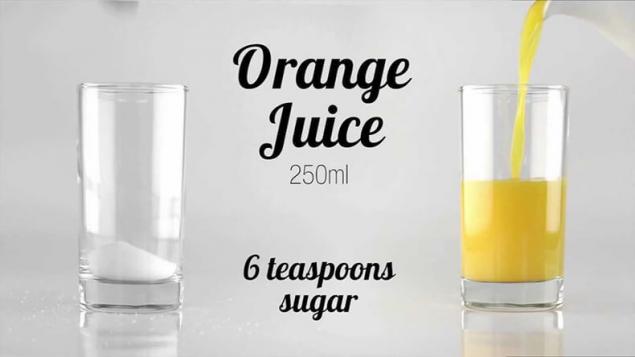
A glass of juice, along with vitamins and antioxidants we get also a portion of sugar. But the juices, in contrast to whole fruit, contain almost no fiber, which has no energy value, so they have more calories per unit mass. The average Cup of grapes contains 62 calories, and the same amount of juice gives you more than 100 calories. Barry Popkin, a specialist in nutrition from the University of North Carolina chapel hill, believes that a glass of juice is not much different from a glass of sweet drinks: no benefit and only unnecessary 110-180 kcal. In his opinion, excessive sweet drinks — one of the reasons that the US so many obese people. But scientists from Johns Hopkins University recently announced that the juices don't satisfy your hunger. A minimum of calories in 180 ml (thin Cup): Apple juice is 87 calories and 22 grams of sugar grapefruit — 70 calories and 17 g of orange — 78 kcal and 18 g grape — 116 kcal and 29 g of pineapple — 104 kcal and 26 g of sugar
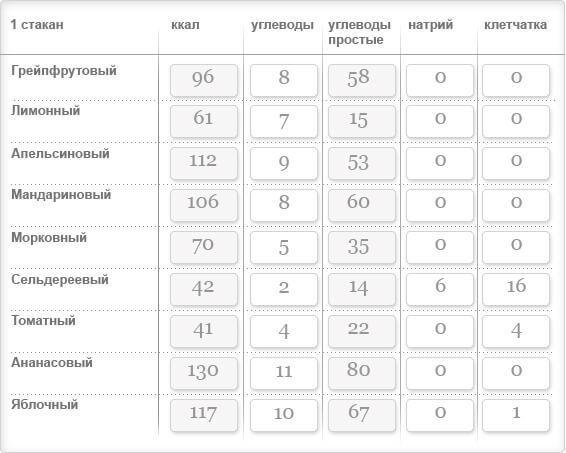
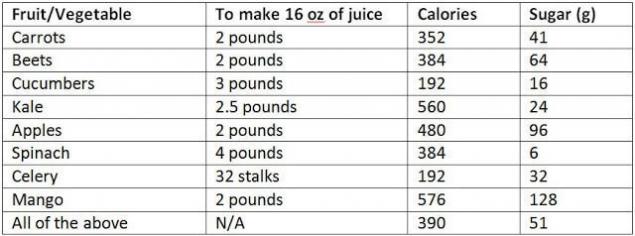
Strike two: high insulin and high glycemic index. The rate of absorption of soluble sugars is much higher than in the whole fruits. Glucose and fructose in fruits and vegetables from which you drink, are in a bound state with the matrix product. To extract and to metabolize carbohydrates, the body needs time to breakdown of more complex carbohydrates. And the finished fruit or vegetable drink is a ready — made carbohydrates which are very quickly and easily absorbed in the mouth. Let us imagine two oranges. One we just cleaned, eaten and out the other, squeeze the juice and drink it. What happens when the juice gets to our stomach and then intestines? It contained sugar in soluble form will instantly fly into the bloodstream to spur the insulin. If we just eat an orange, then our body will have to spend the time and effort to extract from him sugar. Thus the receipt of it in the blood will not be as rapid as from the juice. Insulin will stand out slowly and gradually. When drinking the same juice insulin will stand out instantly and in greater numbers than necessary, and the excess it will contribute to fat deposition.
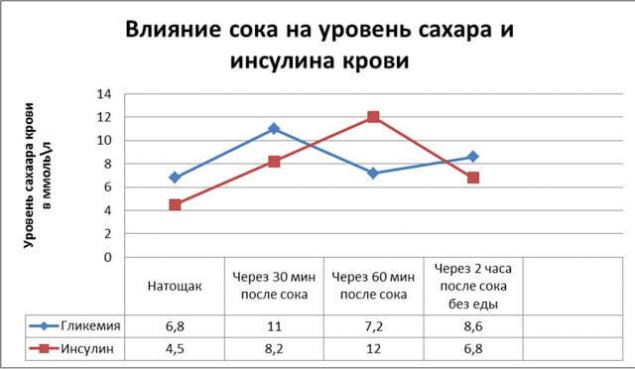
Each product has its own glycemic index. It is a measure of the influence of food on blood sugar levels. The glycemic index is divided into low (0-40), medium (40-55) and high (55-100). 100 is equivalent to pure glucose. So here is the whole Apple has a glycemic index of 35 (low). And have fresh Apple juice index grows to 50 (average). The sugar content of the Apple depends on the variety of Apple, but the average is 10-12g. And in the freshly squeezed juice of 20-24g of sugar. In this regard, an increase in the caloric content of fresh juice respectively 52ккал fresh Apple to almost 100 kcal of juice. Since the glycemic index and sugar level of the juice is high, in addition to vitamins, we get a lot of quickly absorbed carbohydrates.

Strike three: acid. The excess of organic acids has a negative impact: the damage to the teeth, irritation of the gastric mucosa, acid mask the sugar. Exactly the same principle uses Coca-Cola: phosphoric acid masks the nauseating amounts of sugar, slight acidity seems nice. Juices many organic acids (askorbinka, too acid!), increasing the acidity of gastric juice. Therefore, when gastritis with high acidity and gastric ulcer is best not to risk it. In addition, fresh juices contain many organic compounds that increase the acidity of gastric juice. The fourth blow: poor calories. The absolute number of useful components remain in the oil cake. Goes into the juice is almost all sugar and part water-soluble vitamins. Strike five: an excess of certain substances. The excess occurs because eat such a quantity of whole fruits or vegetables is very difficult. But with juice you can easily get an excess of harmful substances, and the excess of vitamins can also be harmful. Some time ago, scientists from the University of North Carolina chapel hill found in grapefruit juice furanocoumarin — a substance that slows the destruction of antihistamine and antiviral drugs, antibiotics, steroid hormones and dozens of other drugs. So they accumulate in the blood, increasing the risk of side effects and overdose. And some studies show that grapefruit juice (a surplus!) can cause breast cancer in women at menopause. If you eat a lot of vitamin C, it can lead to impaired absorption of vitamin B12, which is responsible for blood formation and the nervous system. The Directorate of food and drug administration recommends that you carefully read the label and dilute juices with water. A person needs only 60 mg of vitamin C a day — so contains a half Cup of fresh orange juice. The strike is the sixth hidden calories. Held at the University of Glasgow research has revealed that people often do not have a true picture of the amount of sugar in various drinks. Under the influence of stereotypes formed by the media, they tend to exaggerate the benefits of non-alcoholic cocktails, fresh juices, shakes, smoothies and other non-carbonated artificially liquids. In the survey, the researchers asked the participants to rate offhand, how many teaspoons of sugar are contained in offered for tasting beverages. A portion of each ranged from 330 ml to 1 liter. The results showed that the error is quite significant. For example, fresh pomegranate juice, respondents are considered quite harmless, although in reality the sugar in it was 5 times more than my wildest assumptions. Chocolate milkshakes error was two-fold. British scientists note that the result of such misconceptions be more than 3 thousand calories weekly, or about 450 calories each day. Almost a quarter of the recommended daily calorie intake for women and about 1/5 for men.
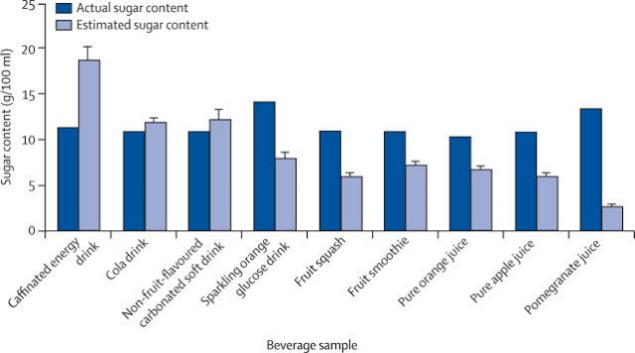
Strike seven: you drink less water. Juice not only quenches thirst, but rather disguises it, only exacerbating the dehydration. According to Professor Susan Jebb (Susan Jebb) from the University of Oxford, it is wrong to use fruit juices to quench your thirst of children. "Water is the best fluid needed in our diet," she said. The eighth blow: a specific effect on the digestion of Soluble components of different juices can have a surprising effect on digestion: increase the production of stomach acid, Kabat, increase the excess gas. This is particularly admonition of the pancreas and gallbladder. Juices stimulate their work and can provoke acute pancreatitis and cholecystitis — diseases are quite serious. Flatulence cause of grape, pear and Apple juices. A large part of the vegetable juice not sickly weak. The ninth blow: no fiber (soluble and insoluble) In the juices completely lacking in fiber or, as it is also called dietary fiber, which is important for normal functioning of the gastrointestinal tract, feelings of fullness, flora and many other things. So, one orange, for example, provides 12% DV of fiber and only 12 grams of sugar, while a glass of orange juice, which takes three or four oranges, contains 26 grams of sugar and no fiber at all. Kick tenth: any juice for children is more harmful than sweetness. In the beginning of this year in the journal the Lancet Diabetes and Endocrinology it was reported that consumption of fruit juice (fresh or recovered) may have a negative impact on human health in the same way that drinking sweetened drinks, as they both contain about the same amount of sugar. In this regard, the authors of the study recommended to drink no more than 150 ml of juice per day.
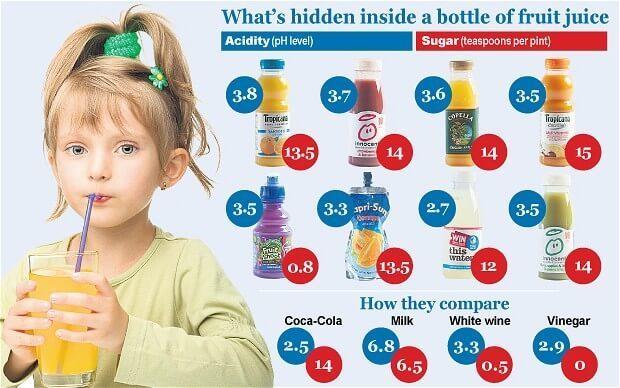
"Many parents buy juice and juice drinks for their children, considering them beneficial for health. In reality, however, children need to give the juice every day, but only periodically – like sweets," said nutritionist Cautery HaShem (Kawther Hashem). The main argument is the presence in the restored juice 6 teaspoons of sugar in a glass of water, even more than Coca-Cola. It is fraught with the development of diabetes, obesity, tooth decay and So the baby juice you can give only occasionally, as an alternative to candy or other sweets. Moreover, it is not necessary to give juice to quench your thirst, because the effect is exactly the opposite. Also, the juice is often added citric acid that impedes the absorption of calcium and contributes to the destruction of tooth enamel. Juices can cause an allergic reaction, diarrhea, provoke the development of dysbacteriosis and diseases of the gastrointestinal tract.
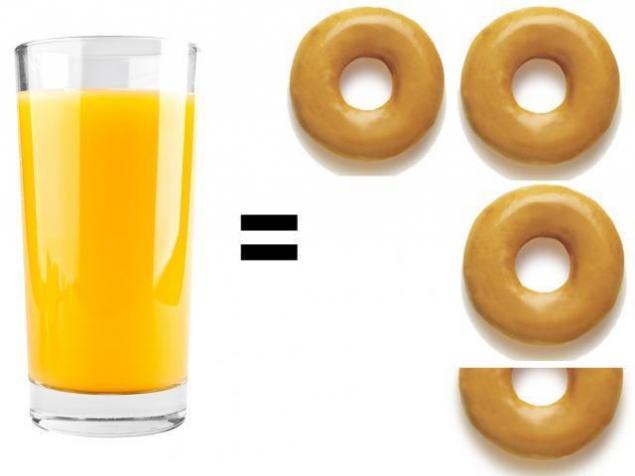
Kick eleventh: Allergy. Jump juices and sugar cause diathesis in children, worsen the indicators of immunity. But do not forget that the juice – the product is non-allergenic, so its excess will certainly respond in the form of redness on your skin, Allergy or risk of Allergy. Strike twelve: diabetes. Meanwhile, head of research of obesity and nutrition Susan Jebb from Oxford says that sugar (albeit natural) orange juice (even packaged, though fresh) is absorbed into the bloodstream almost instantly. It raises the level of glucose in the blood, and is automatically unscheduled release of insulin. Because of this, exhausted pancreas. Susan Jebb estimated that people consume daily juice in large quantities, the risk of developing diabetes are higher by about 20 percent. Researchers from the school of medicine of Harvard University (USA) found that fruit juices may contribute to the development of type II diabetes. Experts have noticed that women who daily drink 3 glass of Apple juice, the risk of this disease increases by 15%. Daily consumption of orange juice increases not only the likelihood of developing the disease by 25%, and obesity. Conclusion. Eat whole fruits and vegetables! Besides that if you have an Apple, it makes no sense to waste time and make him a juice to get the benefits. Healthier it will not only lose their some properties. Think of the juices, including freshly squeezed to like the pampering, the delicious.
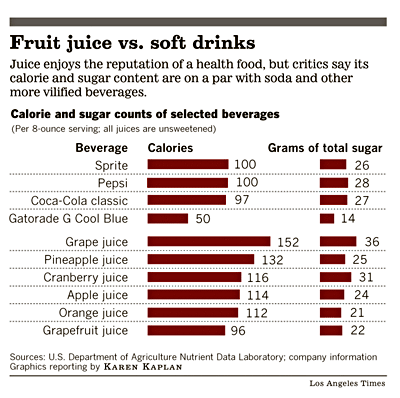
Of course, all of these dangers arise when systemic use the juice from the same glass occasionally harm will not be exact.published Author: Andrey Blueskin see also:
Dr. Hamer: what we call disease is not a pointless ordeal
How to fix flat feet
P. S. And remember, only by changing their consumption — together we change the world! ©
Join us in Facebook , Vkontakte, Odnoklassniki
Source: www.beloveshkin.com/2016/05/ehpidemiya-svezhevyzhatykh-i-paketirovannykh-sokov-12-udarov-po-vashemu-zdorovyu.html
In America and then in Europe, the daily consumption of freshly squeezed juice has become a trend, a cult. In our environment the imposition of juice is also very aggressive. Spend juice detox, cure disease and even trying to live.
Below I will tell you why this is all wrong and why juice, even freshly squeezed, essentially sugar water. For example, 250 ml of Apple juice contain 110 kcal and 26 g of sugar and Coca-Cola in the same volume contains 105 kcal and 26.5 g of sugar. The difference is insignificant, and the action is the same.

Strike one: sugar. 1 Cup (200 ml) of any fruit juice WITHOUT SUGAR contains an average of 20-24 mg of sugars, which for 30 minutes will increase blood glucose by 3-4 mmol\L. On the content of sugars (free, they are also extracellular, added, rastvornye) as packaged nectars and fresh-squeezed juices comparable to sweet drinks. And this sugar, liquid calories, acts on the body just like a Cola or sprite. This is due to the fact that many juices, including baby food, contain at least six teaspoons of sugar (200 ml) – more than Coca-Cola.

A glass of juice, along with vitamins and antioxidants we get also a portion of sugar. But the juices, in contrast to whole fruit, contain almost no fiber, which has no energy value, so they have more calories per unit mass. The average Cup of grapes contains 62 calories, and the same amount of juice gives you more than 100 calories. Barry Popkin, a specialist in nutrition from the University of North Carolina chapel hill, believes that a glass of juice is not much different from a glass of sweet drinks: no benefit and only unnecessary 110-180 kcal. In his opinion, excessive sweet drinks — one of the reasons that the US so many obese people. But scientists from Johns Hopkins University recently announced that the juices don't satisfy your hunger. A minimum of calories in 180 ml (thin Cup): Apple juice is 87 calories and 22 grams of sugar grapefruit — 70 calories and 17 g of orange — 78 kcal and 18 g grape — 116 kcal and 29 g of pineapple — 104 kcal and 26 g of sugar


Strike two: high insulin and high glycemic index. The rate of absorption of soluble sugars is much higher than in the whole fruits. Glucose and fructose in fruits and vegetables from which you drink, are in a bound state with the matrix product. To extract and to metabolize carbohydrates, the body needs time to breakdown of more complex carbohydrates. And the finished fruit or vegetable drink is a ready — made carbohydrates which are very quickly and easily absorbed in the mouth. Let us imagine two oranges. One we just cleaned, eaten and out the other, squeeze the juice and drink it. What happens when the juice gets to our stomach and then intestines? It contained sugar in soluble form will instantly fly into the bloodstream to spur the insulin. If we just eat an orange, then our body will have to spend the time and effort to extract from him sugar. Thus the receipt of it in the blood will not be as rapid as from the juice. Insulin will stand out slowly and gradually. When drinking the same juice insulin will stand out instantly and in greater numbers than necessary, and the excess it will contribute to fat deposition.

Each product has its own glycemic index. It is a measure of the influence of food on blood sugar levels. The glycemic index is divided into low (0-40), medium (40-55) and high (55-100). 100 is equivalent to pure glucose. So here is the whole Apple has a glycemic index of 35 (low). And have fresh Apple juice index grows to 50 (average). The sugar content of the Apple depends on the variety of Apple, but the average is 10-12g. And in the freshly squeezed juice of 20-24g of sugar. In this regard, an increase in the caloric content of fresh juice respectively 52ккал fresh Apple to almost 100 kcal of juice. Since the glycemic index and sugar level of the juice is high, in addition to vitamins, we get a lot of quickly absorbed carbohydrates.

Strike three: acid. The excess of organic acids has a negative impact: the damage to the teeth, irritation of the gastric mucosa, acid mask the sugar. Exactly the same principle uses Coca-Cola: phosphoric acid masks the nauseating amounts of sugar, slight acidity seems nice. Juices many organic acids (askorbinka, too acid!), increasing the acidity of gastric juice. Therefore, when gastritis with high acidity and gastric ulcer is best not to risk it. In addition, fresh juices contain many organic compounds that increase the acidity of gastric juice. The fourth blow: poor calories. The absolute number of useful components remain in the oil cake. Goes into the juice is almost all sugar and part water-soluble vitamins. Strike five: an excess of certain substances. The excess occurs because eat such a quantity of whole fruits or vegetables is very difficult. But with juice you can easily get an excess of harmful substances, and the excess of vitamins can also be harmful. Some time ago, scientists from the University of North Carolina chapel hill found in grapefruit juice furanocoumarin — a substance that slows the destruction of antihistamine and antiviral drugs, antibiotics, steroid hormones and dozens of other drugs. So they accumulate in the blood, increasing the risk of side effects and overdose. And some studies show that grapefruit juice (a surplus!) can cause breast cancer in women at menopause. If you eat a lot of vitamin C, it can lead to impaired absorption of vitamin B12, which is responsible for blood formation and the nervous system. The Directorate of food and drug administration recommends that you carefully read the label and dilute juices with water. A person needs only 60 mg of vitamin C a day — so contains a half Cup of fresh orange juice. The strike is the sixth hidden calories. Held at the University of Glasgow research has revealed that people often do not have a true picture of the amount of sugar in various drinks. Under the influence of stereotypes formed by the media, they tend to exaggerate the benefits of non-alcoholic cocktails, fresh juices, shakes, smoothies and other non-carbonated artificially liquids. In the survey, the researchers asked the participants to rate offhand, how many teaspoons of sugar are contained in offered for tasting beverages. A portion of each ranged from 330 ml to 1 liter. The results showed that the error is quite significant. For example, fresh pomegranate juice, respondents are considered quite harmless, although in reality the sugar in it was 5 times more than my wildest assumptions. Chocolate milkshakes error was two-fold. British scientists note that the result of such misconceptions be more than 3 thousand calories weekly, or about 450 calories each day. Almost a quarter of the recommended daily calorie intake for women and about 1/5 for men.

Strike seven: you drink less water. Juice not only quenches thirst, but rather disguises it, only exacerbating the dehydration. According to Professor Susan Jebb (Susan Jebb) from the University of Oxford, it is wrong to use fruit juices to quench your thirst of children. "Water is the best fluid needed in our diet," she said. The eighth blow: a specific effect on the digestion of Soluble components of different juices can have a surprising effect on digestion: increase the production of stomach acid, Kabat, increase the excess gas. This is particularly admonition of the pancreas and gallbladder. Juices stimulate their work and can provoke acute pancreatitis and cholecystitis — diseases are quite serious. Flatulence cause of grape, pear and Apple juices. A large part of the vegetable juice not sickly weak. The ninth blow: no fiber (soluble and insoluble) In the juices completely lacking in fiber or, as it is also called dietary fiber, which is important for normal functioning of the gastrointestinal tract, feelings of fullness, flora and many other things. So, one orange, for example, provides 12% DV of fiber and only 12 grams of sugar, while a glass of orange juice, which takes three or four oranges, contains 26 grams of sugar and no fiber at all. Kick tenth: any juice for children is more harmful than sweetness. In the beginning of this year in the journal the Lancet Diabetes and Endocrinology it was reported that consumption of fruit juice (fresh or recovered) may have a negative impact on human health in the same way that drinking sweetened drinks, as they both contain about the same amount of sugar. In this regard, the authors of the study recommended to drink no more than 150 ml of juice per day.

"Many parents buy juice and juice drinks for their children, considering them beneficial for health. In reality, however, children need to give the juice every day, but only periodically – like sweets," said nutritionist Cautery HaShem (Kawther Hashem). The main argument is the presence in the restored juice 6 teaspoons of sugar in a glass of water, even more than Coca-Cola. It is fraught with the development of diabetes, obesity, tooth decay and So the baby juice you can give only occasionally, as an alternative to candy or other sweets. Moreover, it is not necessary to give juice to quench your thirst, because the effect is exactly the opposite. Also, the juice is often added citric acid that impedes the absorption of calcium and contributes to the destruction of tooth enamel. Juices can cause an allergic reaction, diarrhea, provoke the development of dysbacteriosis and diseases of the gastrointestinal tract.

Kick eleventh: Allergy. Jump juices and sugar cause diathesis in children, worsen the indicators of immunity. But do not forget that the juice – the product is non-allergenic, so its excess will certainly respond in the form of redness on your skin, Allergy or risk of Allergy. Strike twelve: diabetes. Meanwhile, head of research of obesity and nutrition Susan Jebb from Oxford says that sugar (albeit natural) orange juice (even packaged, though fresh) is absorbed into the bloodstream almost instantly. It raises the level of glucose in the blood, and is automatically unscheduled release of insulin. Because of this, exhausted pancreas. Susan Jebb estimated that people consume daily juice in large quantities, the risk of developing diabetes are higher by about 20 percent. Researchers from the school of medicine of Harvard University (USA) found that fruit juices may contribute to the development of type II diabetes. Experts have noticed that women who daily drink 3 glass of Apple juice, the risk of this disease increases by 15%. Daily consumption of orange juice increases not only the likelihood of developing the disease by 25%, and obesity. Conclusion. Eat whole fruits and vegetables! Besides that if you have an Apple, it makes no sense to waste time and make him a juice to get the benefits. Healthier it will not only lose their some properties. Think of the juices, including freshly squeezed to like the pampering, the delicious.

Of course, all of these dangers arise when systemic use the juice from the same glass occasionally harm will not be exact.published Author: Andrey Blueskin see also:
Dr. Hamer: what we call disease is not a pointless ordeal
How to fix flat feet
P. S. And remember, only by changing their consumption — together we change the world! ©
Join us in Facebook , Vkontakte, Odnoklassniki
Source: www.beloveshkin.com/2016/05/ehpidemiya-svezhevyzhatykh-i-paketirovannykh-sokov-12-udarov-po-vashemu-zdorovyu.html






